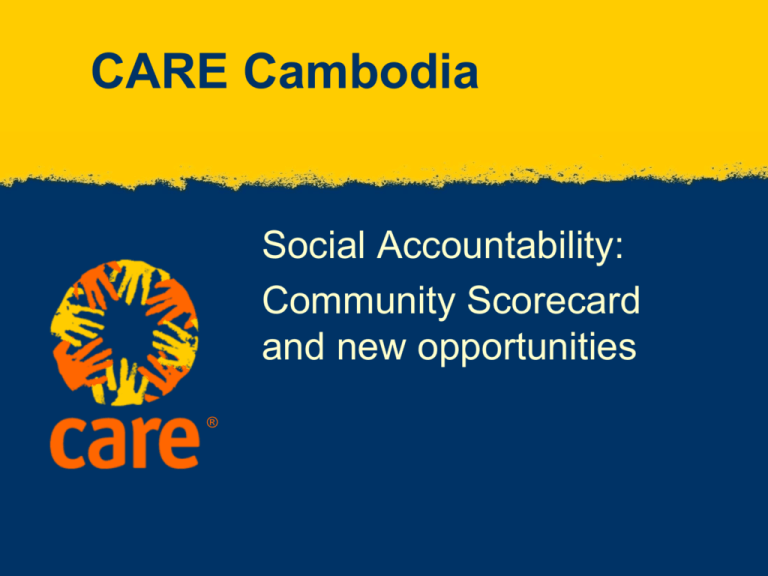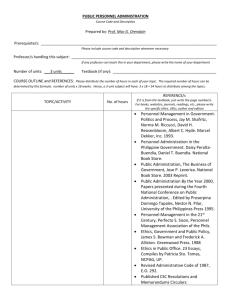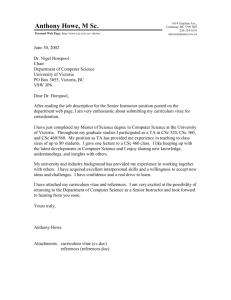
CARE Cambodia
Social Accountability:
Community Scorecard
and new opportunities
®
Global Fund R9 : Health Strengthening Systems
Goal
To strengthen good governance in the health System through
community participation to attain access to quality health
services inc. HIV, Malaria and TB
HSS Project is
5 years
$2.2 million USD
3 provinces with local partners
Provinces are remote and include Ethnic Minorities
®
© 2005, CARE USA. All rights reserved.
Objectives
1.
to strengthen community participation and capacity
to voice and concerns, access to information and
participation in decision making at a local level
2. to strengthen the capacity of the commune, district
and provincial councils to raise the priorities and
concerns of their constituents through the health
centre management committee, village health
support groups, technical working group on health
and support community health initiatives through
commune investment plans
®
© 2005, CARE USA. All rights reserved.
Ob 1 : Community Participation and Voice
Conduct workshops to develop understanding on eligibility for
exemptions for the poor, general health services and respective
responsibilities.
Sensitise the most vulnerable and marginalised to their rights
to develop their confidence levels, and ability to speak out on
issues of concern.
Develop the capacity of the most vulnerable and marginalised
to identify key concerns and priorities in preparation for both
the annual village level needs assessment (as part of the local
planning process) conducted by the Commune Council and to
present issues at the monthly Commune Council meetings.
®
© 2005, CARE USA. All rights reserved.
Support public forums at each Health Centre every six months
with the participation of all key stakeholders to identify key
concerns and develop action plans to address the key priorities
and provide opportunity for health service providers to respond
and give updates on actions taken.
Train and support VHSG representatives to carry out annual
user satisfaction surveys at their local health facility
®
© 2005, CARE USA. All rights reserved.
Obj 2: Raise capacity of local health service providers to raise
priorities and concerns of citizens
Capacity building to the Planning and Budgeting Committees :
commune council to manage lists of poor households
identified (Ministry of Planning : IDPoor) and ensure those
eligible for exemption at health centres have the appropriative
documents – equity cards.
Develop the capacity of HCMC to monitor utilisation rates by
those identified as poor and disseminate results through the
six monthly public forum.
In collaboration with Commune Councils and communities
establish a model referral system supported financially by the
Commune Council.
®
© 2005, CARE USA. All rights reserved.
Obj 2
Develop with key stakeholders appropriate IEC materials using
a variety of media which are appropriate for non literate
populations focusing on, service availability and client and
provider rights.
Advocate to the Ministry of Health for policy change
specifically the Community Participation Policy to increase
decision making rights of Commune Councils on HCMC and
Health Equity Fund Committees.
Ensure HCMC and VHSG are integrated into all maternal death
audits and that communities are kept informed of outcomes of
such audits through the public forums and empowered to
support prevention of Maternal Mortality through pro-active
birth planning
®
© 2005, CARE USA. All rights reserved.
What helps us address good governance in health
•Community Participation Policy (CPP),
•Client Rights/Provider Rights (CRPR) -MOH
•Minimum Package of Activities (MPA)-MOH
What limits us in facilitating good governance in health
•Severe limited resources (corruption)
•Low salaries eg. Midwife approx $40 a month (excludes
user fee) ; GFW =$75 plus overtime
•Low understanding of social accountability
®
© 2005, CARE USA. All rights reserved.
Community Score Card
At proposal stage tools such as the CSC had not been pre
identified
In phase 1 some activities have progressed well and others
less so as we seek ways to implement
GF : budget restrictions
The CSC entails three main events, a service user (in this case,
whole community) meeting, a service provider (in this case,
health centre staff) meeting, and an interface meeting with
service users and providers represented resulting in an action
plan for implementation.
®
© 2005, CARE USA. All rights reserved.
Implemented through local partners in 3 provinces who are now in the
3rd round.
The World Bank has also been piloting the use of the CSC in the
health system in Cambodia ( 6 local partners) and has submitted their
own version of the CSC manual to MOH which has been
acknowledged and accepted for use by MOH.
Last year Care took the lead to organise a workshop to exchange
experiences between different stake holders involved in the CSC in
Cambodia
CARE also coordinates the Social Accountability network of NGOs
implementing the health CSC ( open to other NGOs implementing
similar social accountability mechanism)
®
© 2005, CARE USA. All rights reserved.
Barriers reported by users to health services
Chart Title
Other
Transportation was expensive
Service fee was expensive
No medicine given
Unfriendly staff behavior
Difficulty for travel
No money to pay
Long waiting time
There was a barrier
0
10
Total
®
© 2005, CARE USA. All rights reserved.
20
Male
30
Female
40
50
60
70
Barriers to health service delivery
Chart Title
No technical support from higher level
Lack of skills and capacity
Too many patients
Health staff are too busy
Low salary
Patients wants injections
Lack of essential drug
Lack of medical equipments
Patients lack understanding on health services
Face barriers in providing health care
0
10
Total
®
© 2005, CARE USA. All rights reserved.
20
Women
30
Men
40
50
60
70
80
90
CSC Results
CSC activity itself (in line with the CARE manual) has been
relatively successfully implemented through local partners
All stakeholders have been willing to participate in scoring and
interface meeting at HC level
Local partners can successfully aggregate results (scores)
and share information with the different provider levels up to
to Provincial level
MOH and health providers accept the CSC tool and results
presented
®
© 2005, CARE USA. All rights reserved.
Important to note
We are not expecting the CSC to result in the commune council
allocating funds to pay for large health clinic renovations to take place
but we do expect small level changes eg a promise by the HC that
certain hours the clinic will be staffed eg every Tuesday and Thursday
morning or the community and HC promise to clean the clinic every
thursday afternoon
The emphasis is on creating the space and the practice that in the longer
term with decentralization and increased budget power at local level
greater changes can take place
®
© 2005, CARE USA. All rights reserved.
CSC further developments
Need to improve CSC step 4 : Action Plan implementation and M&E
Adopt a mechanism to capture the negotiation that took place, the
key players, the role of women & other vulnerable groups, the
decisions made (promises) and the follow up
2 out of 3 local partners have a low capacity-need capacity build in
how and what information we want captured
Local partners need to move into a more facilitation role rather than
direct implementers
®
© 2005, CARE USA. All rights reserved.
Next steps : Scale Up
Community Score Card (health)
Global Fund – 2 years up to 2015
Partnering to Save Lives (MCH) runs up to 2017 (CSC will also be
shared /adopted by Save the Children)
= 100% coverage in 6 provinces
Multi Sector Score Card
World Bank/GOV – ISAF
3 sectors 1st : Commune services, education, health
CARE : proposal $2 million USD
“Voice and Action: Social Accountability for the Poor”, 2014-2017
Targeting : 445,000 adults and 58,000 youths in 4 provinces
Focus role out training to local NGOS in the score card
®
© 2005, CARE USA. All rights reserved.
WB led Implementing Social Accountability Framework
Objective of the WB-supported ISAF program:
“Empower citizens and community groups to enhance the allocation of
resources and delivery of local public services through improved
access to information and the participatory monitoring of budgets and
performance.”
®
© 2005, CARE USA. All rights reserved.
National Program for Sub National Democratic Development
Since 2003, the RGC -support from the World Bank, JICA etc has
implemented a program aimed at enhancing government
responsiveness by establishing a functioning sub-national system of
government with elected commune councils.
The National Program for Sub-National Democratic Development
2010–2019, clearly set out the Government's intention to establish a
democratically-elected and locally accountable sub-national
governance system, supported by local budgets to empower councils
and with the promise of engaging citizens in local decision-making.
World Bank provides the National Committee for Sub-National
Democratic Development (NCDD-S) with the technical support
necessary to strengthen the demand-side dimension of the
decentralization process. The result of this support is the recently
endorsed “Social Accountability Framework”
®
© 2005, CARE USA. All rights reserved.
Principles of the ISAF
1.
Citizen-led approach
2.
Focus on local level (district and lower)
3.
Constructive engagement
4.
Requires mutual commitment
5.
Based on partnership
6.
Must be inclusive
7.
Seeks to address systemic gaps
®
© 2005, CARE USA. All rights reserved.
ISAF- strategies
The Social Accountability Framework (SAF) action plan links together demand
and supply side activity around three strategies that have the possibility of
transforming local governance processes:
(1) Access to Information, to improve transparency and access to information
on standards, budgets, expenditures and performance;
(2) Citizen monitoring – to introduce facilitated citizen/user monitoring and
reporting of commune and basic services;
(3) Budget work to improve citizens’ budget literacy and strengthen their
inquiry of public budgets and expenditures. And two enabling strategies:
(4) Facilitation– to engage state and non-state actors and build skills to
facilitate the engagement and social accountability process; and (5) Learningto learn lessons from local interventions and translate these into government
policy and improved CSO practice.
®
© 2005, CARE USA. All rights reserved.
Key Distinguishing Characteristics of the ISAF
•
I-SAF based on a framework endorsed by government
and CSOs.
•
Government and civil society actions carried out by
both… coordinated.
•
Approach is:
– multi-sectoral - enable citizens/communities to decide
what they want to devote time and attention to.
– relies on the continued empowerment of citizens
– relies on key roles for elected councilors
®
© 2005, CARE USA. All rights reserved.
•
Proposed practices are institutionalized/incorporated into
existing systems and structures.
•
Focus on building capacity and skills for sustained action
within communities.
•
Local NGOs play a mentoring/accompanying role rather than a direct implementation role.
•
Explicit focus on bringing together state and non-state
actors and improving/strengthening
®
© 2005, CARE USA. All rights reserved.
Benefits to participating communities
communities can approach and discuss their development needs,
service concerns and other issues with appropriate authorities,
free flow and transfer of information between communities and
commune councils, increased transparency in decision making and
greater community cohesion.
In the longer term, it is expected that there will be improved access to
basic services for communities, better quality of services and a more
appropriate allocation of resources based on community needs.
Specific women’s concerns, which may include issues of gender
based violence, health and child care and participation, which
currently may not be addressed, will be raised and responses
prioritized
®
© 2005, CARE USA. All rights reserved.
Again its important to note this is a long term process
and we are not expecting citizens to have huge impacts
on services at local level but again looking for small
changes the citizens can influence and commune council
can carry out with limited resources.
Aggregation of citizen satisfaction and concerns can be
complied by central source and MOH to receive
The opportunism is in the decentralizing progresses and
as commune councils have greater budget control the
more costly concerns of citizens can be addressed.
®
© 2005, CARE USA. All rights reserved.
®
© 2005, CARE USA. All rights reserved.







